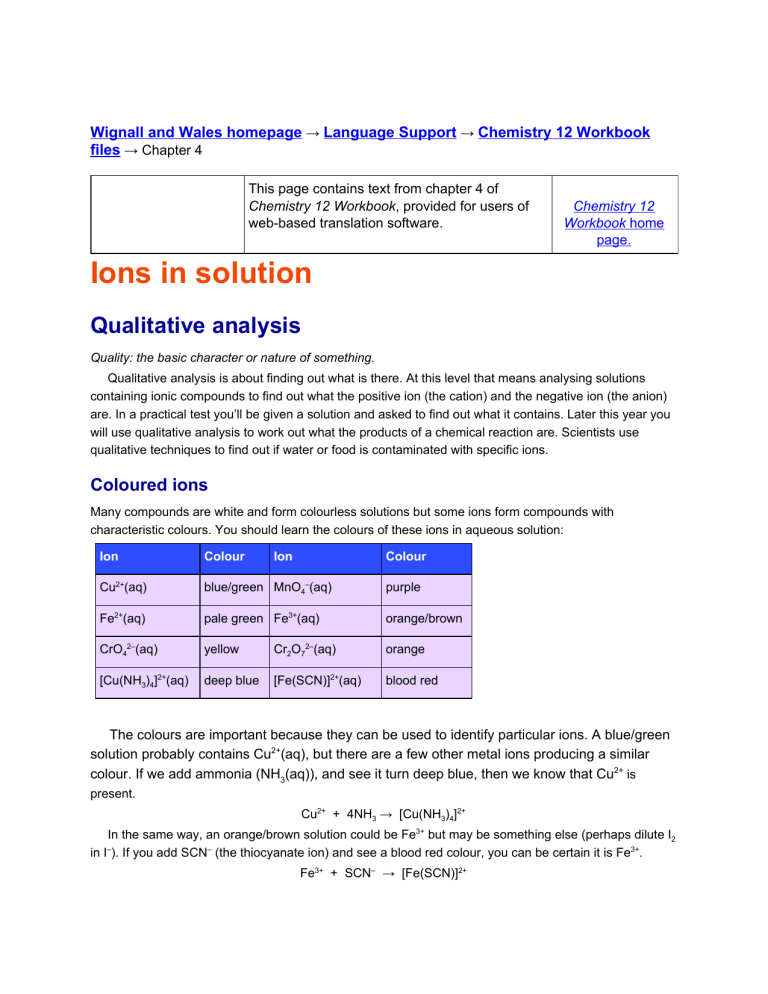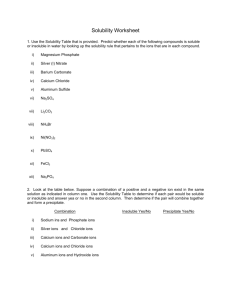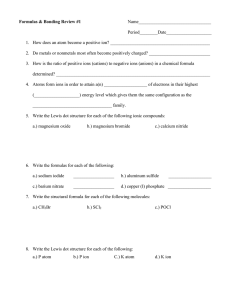1.1 Chemistry 12 Chapter 4 Ions in solution
advertisement

Wignall and Wales homepage → Language Support → Chemistry 12 Workbook files → Chapter 4 This page contains text from chapter 4 of Chemistry 12 Workbook, provided for users of web-based translation software. Chemistry 12 Workbook home page. Ions in solution Qualitative analysis Quality: the basic character or nature of something. Qualitative analysis is about finding out what is there. At this level that means analysing solutions containing ionic compounds to find out what the positive ion (the cation) and the negative ion (the anion) are. In a practical test you’ll be given a solution and asked to find out what it contains. Later this year you will use qualitative analysis to work out what the products of a chemical reaction are. Scientists use qualitative techniques to find out if water or food is contaminated with specific ions. Coloured ions Many compounds are white and form colourless solutions but some ions form compounds with characteristic colours. You should learn the colours of these ions in aqueous solution: Ion Colour Ion Colour Cu2+(aq) blue/green MnO4–(aq) purple Fe2+(aq) pale green Fe3+(aq) orange/brown CrO42–(aq) yellow Cr2O72–(aq) orange [Cu(NH3)4]2+(aq) deep blue [Fe(SCN)]2+(aq) blood red The colours are important because they can be used to identify particular ions. A blue/green solution probably contains Cu2+(aq), but there are a few other metal ions producing a similar colour. If we add ammonia (NH3(aq)), and see it turn deep blue, then we know that Cu2+ is present. Cu2+ + 4NH3 → [Cu(NH3)4]2+ In the same way, an orange/brown solution could be Fe3+ but may be something else (perhaps dilute I2 in I ). If you add SCN– (the thiocyanate ion) and see a blood red colour, you can be certain it is Fe3+. – Fe3+ + SCN– → [Fe(SCN)]2+ The ions [Cu(NH3)4]2+ and [Fe(SCN)]2+ are called complex ions because they are made by combining several species together into a new ion. The complexes you meet this year are all soluble in water to form clear solutions. The solubility of ionic compounds Chemists need to know the solubilities of dozens of ionic compounds, but as always, we look for patterns to make remembering easier. Solubility rules • All sodium, potassium and ammonium salts are soluble. • All nitrates are soluble. • All chlorides are soluble except silver chloride; lead chloride is slightly soluble. • All sulfates are soluble except for lead sulfate and barium sulfate: calcium sulfate and silver sulfate are slightly soluble. • All carbonates and hydroxides are insoluble except those of sodium, potassium and ammonium: calcium hydroxide is slightly soluble. Use the solubility rules above to complete this table. Positive ion nitrate chloride sulfate carbonat e hydroxid e ammoniu m sodium ✓ potassium magnesiu m aluminium zinc calcium ✗ copper silver ✓ ss ✓ iron(II) iron(III) lead ✓ = soluble ss ✗ = insoluble ss = slightly soluble Predicting precipitates black = not formed An ionic compound dissolves if the ions are more strongly attracted to water molecules than they are to each other. When an ionic compound dissolves, its ions separate and are free to move throughout the solution. A precipitate is a solid formed when two solutions are mixed. NaCl(s) → Na+(aq) + Cl–(aq) If this solution is mixed with another solution, the two sets of ions can move freely throughout the combined solution. A precipitate will form if a combination of ions occurs that is insoluble. For example, a precipitate of silver chloride forms when silver nitrate solution is mixed with sodium chloride solution: AgNO3(aq) + NaCl(aq) → AgCl(s) + NaNO3(aq) Silver ions are more strongly attracted to water molecules than they are to nitrate ions, so silver nitrate is soluble. However, silver ions are more strongly attracted to chloride ions than to water molecules, so silver chloride is insoluble. The actual reaction occurs between the silver ions and chloride ions, so chemists often just write an ionic equation instead: Ag+(aq) + Cl–(aq) → AgCl(s) The sodium ions and nitrate ions take no part in the reaction. Since they appear to just “sit back and watch” they are called spectator ions. Identification of ions To identify ions in solution we make use of our knowledge of the colours of ions, the formation (or lack of formation) of precipitates, and the formation (or lack of formation) of complex ions. Tests for anions (negative ions) You are required to identify Cl–, I–, SO42–, CO32–, OH– and NO3– in solution. To do so, you can use the unique characteristics of each ion. Carbonate and hydroxide Solutions contain the CO32– or OH– ions will be basic — they turn red litmus blue. If the solution fizzes when dilute acid is added, then CO32– is present: CO32–(aq) + 2H+(aq) → CO2(g) + H2O(aq) You can confirm that the gas produced is CO2 by collecting a little of the gas in a dropper and expelling the gas into 1 mL of limewater. If CO2(g) is present the limewater turns cloudy: CO2(g) + Ca(OH)2(aq) → CaCO3(s) + H2O(l) If the test solution turns litmus blue but does not fizz in acid then it contains OH– ions. Halide ions (Cl– or I–) Most halide compounds are soluble, but silver chloride, bromide and iodide are insoluble. To test for halide ions, take about 1 mL of the unknown solution and add 1 mL of dilute nitric acid (to prevent the formation of unwanted precipitates), then add a few drops of silver nitrate solution. (Caution: silver nitrate solution can stain: if you spill any, wash it off immediately, before it turns your fingers, clothes, books or bench black.) Silver chloride forms a white precipitate: Ag+(aq) + Cl–(aq) → AgCl(s) while silver iodide forms a very pale yellow precipitate: Ag+(aq) + I–(aq) → AgI(s) (The other halide ion, Br–, forms a cream precipitate, but you are not required to test for bromide ions.) If no precipitate forms with silver nitrate solution, then your unknown solution does not contain a halide ion. To confirm the presence of chloride or iodide ions, add 1 mL of dilute ammonia solution. If the precipitate dissolves, it was silver chloride, if it remains, it was silver iodide: AgCl(s) + 2NH3(aq) → [Ag(NH3)2]+(aq) + Cl–(aq) An alternative test for the iodide ion is to add a few drops of lead nitrate solution to the original unknown solution. If iodide ions are present you will see a bright yellow precipitate: Pb2+(aq) + 2I–(aq) → PbI2(s) Sulfate or nitrate Most sulfates are soluble, but an important insoluble sulfate is barium sulfate — because it is the only barium compound that is insoluble in acid conditions. To find out if an unknown solution contains sulfate ions we first acidify it, by adding 1 mL of dilute nitric acid to 1 mL of the unknown solution, and then add a few drops of a barium solution — either barium nitrate, or barium chloride. A white precipitate means that the sulfate ion is present: Ba2+(aq) + SO42– → BaSO4(s) All nitrates are soluble, so we cannot do a precipitation reaction to test for the nitrate ion. If you have tested your unknown solution with litmus, and with silver nitrate, and with barium ions, and there is no reaction, then it is safe (at this level) to assume that the anion present is the nitrate ion. Tests for cations (positive ions) When testing for cations we make use of the fact that almost all metal hydroxides are insoluble, and that several important metal hydroxides have characteristic colours. To sort out the rest, we rely on the formation of certain complex ions. You are required to distinguish between the following cations: NH4+, Cu2+, Fe2+, Fe3+, Ag+, Mg2+, Zn2+, Al , Pb2+ and Na+. 3+ Cations with coloured hydroxides: Cu2+ , Fe2+ , Fe3+ and Ag+ To a 1 mL sample of the unknown, add 2 or 3 drops of sodium hydroxide solution. (Don’t add too much at first or you’ll ruin later tests.) Note the colour of any precipitate that forms. • Light blue = Cu2+ Cu2+(aq) + 2OH–(aq) → Cu(OH)2(s) • Dark green = Fe2+ Fe2+(aq) + 2OH–(aq) → Fe(OH)2(s) • Orange = Fe3+ Fe3+(aq) + 3OH–(aq) → Fe(OH)3(s) • Brown = Ag+ 2Ag+(aq) + 2OH–(aq) → Ag2O(s) + H2O(l) Note: AgOH decomposes on forming. • White = see below If you get a pale blue precipitate, confirm that it is Cu2+ by adding about 5 mL of ammonia solution. You should see the pale precipitate dissolve and form a clear dark ‘ink’ blue colour called royal blue. Cu(OH)2(s) + 4NH3(aq) → [Cu(NH3)4]2+(aq) + 2OH–(aq) Cations with white hydroxides: Mg2+ , Al3+ , Pb2+ and Zn2+ Mg(OH)2, Al(OH)3, Pb(OH)2, and Zn(OH)2 are all white solids, insoluble in water; however, all but Mg(OH)2 will react with excess OH– to form soluble complexes. That’s why it is very important to start testing for cations by adding only one or two drops of sodium hydroxide solution — add too much and the complex will form before you’ve had time to notice the precipitate. Mg2+(aq) + 2OH–(aq) → Mg(OH)2(s) Al3+(aq) + 3OH–(aq) → Al(OH)3(s) Al(OH)3(s) + OH–(aq) → [Al(OH)4]–(aq) Zn2+(aq) + 2OH–(aq) → Zn(OH)2(s) Zn(OH)2(s) + 2OH–(aq) → [Zn(OH)4]2–(aq) Pb2+(aq) + 2OH–(aq) → Pb(OH)2(s) Pb(OH)2(s) + 2OH–(aq) → [Pb(OH)4]2–(aq) To distinguish between the three cations that form complexes with hydroxide, we test a fresh sample of the unknown with ammonia solution. This solution, sometimes labelled ammonium hydroxide, contains some OH–(aq), some NH4+(aq), and high concentrations of NH3(aq). When added to the cation, it first precipitates out the white hydroxide seen earlier. As more ammonia solution is added, the zinc hydroxide will disappear, while the aluminium and lead hydroxides remain: Zn2+(aq) + 2OH–(aq) → Zn(OH)2(s) Zn(OH)2(s) + 4NH3(aq) → [Zn(NH3)4]2+(aq) Most aluminium salts are soluble, while most lead salts are insoluble. To distinguish between these two ions we test fresh solutions of the unknown with an anion which forms a precipitate with lead but not with aluminium. Sulfuric acid (SO42–) is commonly available and forms a white precipitate with Pb2+ while not reacting with Al3+: Pb2+(aq) + SO42–(aq) → PbSO4(s) A more spectacular test for Pb2+ is to add I–, which forms the bright yellow PbI2: Pb2+(aq) + 2I–(aq) → PbI2(s) Cations which form soluble hydroxides: NH4+ and Na+ If no precipitate forms upon addition of sodium hydroxide to the unknown, then the cation must have a soluble hydroxide. (Do the test again with a fresh sample, to make certain you have not added too much OH– at the beginning and formed a complex.) To find out whether the cation is NH4+, add 1 mL sodium hydroxide solution, hold damp red litmus paper at the top of the test tube, and warm the tube over a Bunsen flame. If NH4+ is present it will change into NH3 gas and turn the litmus paper blue: NH4+(aq) + OH–(aq) → NH3(g) + H2O(l) You should also be able to smell the characteristic odour of ammonia. If your test for ammonium is negative, the cation should be Na+. (A flame test can be used to distinguish between Na+ and K+: Na+ makes a yellow flame while K+ turns the flame a lilac colour. However, flame tests are not required for this standard.)





